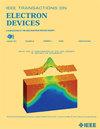High-Mobility and High-Responsivity MoS2 Phototransistor Enabled by Rippled Mg Substrate Engineering
IF 3.2
2区 工程技术
Q2 ENGINEERING, ELECTRICAL & ELECTRONIC
引用次数: 0
Abstract
The 2-D semiconductors, such as molybdenum disulfide (MoS2), have seen extensive use in the fields of electronics and optoelectronics. However, the lower carrier mobility and weak light absorption ability of the ultrathin layered structure greatly limit commercial applications. In this study, we use a single-step UV-ozone oxidation method to transform flat magnesium (Mg) into a rippled substrate, which effectively enhances the carrier mobility of MoS2 from the range of波纹Mg衬底工程实现高迁移率和高响应率MoS2光电晶体管
二维半导体,如二硫化钼(MoS2),已经在电子和光电子领域得到了广泛的应用。然而,超薄层状结构载流子迁移率低,光吸收能力弱,极大地限制了其商业应用。在本研究中,我们使用单步紫外-臭氧氧化方法将平面镁(Mg)转化为脉动衬底,有效地提高了MoS2的载流子迁移率,从$19.2\sim 31.2$到$45.3\sim 78.2$ cm ${}^{{2}} \cdot $ V ${}^{\text {-1}}$ s ${}^{\text{-1}}$。由于从一个峰到另一个峰的多次反射,该器件也显示出1.6\ × 10^{{5}}$ A/W的高光响应性。有趣的是,在适当的栅极偏置下,该器件具有恒定的~220 A/W的光响应性,与入射光强度无关。这项工作提出了一种简单的氧化诱导波纹Mg衬底,同时解决了二维半导体中的低载流子迁移率和弱光吸收问题,实现了电光协同改进,为高性能光电器件的设计铺平了道路。
本文章由计算机程序翻译,如有差异,请以英文原文为准。
求助全文
约1分钟内获得全文
求助全文
来源期刊

IEEE Transactions on Electron Devices
工程技术-工程:电子与电气
CiteScore
5.80
自引率
16.10%
发文量
937
审稿时长
3.8 months
期刊介绍:
IEEE Transactions on Electron Devices publishes original and significant contributions relating to the theory, modeling, design, performance and reliability of electron and ion integrated circuit devices and interconnects, involving insulators, metals, organic materials, micro-plasmas, semiconductors, quantum-effect structures, vacuum devices, and emerging materials with applications in bioelectronics, biomedical electronics, computation, communications, displays, microelectromechanics, imaging, micro-actuators, nanoelectronics, optoelectronics, photovoltaics, power ICs and micro-sensors. Tutorial and review papers on these subjects are also published and occasional special issues appear to present a collection of papers which treat particular areas in more depth and breadth.
 求助内容:
求助内容: 应助结果提醒方式:
应助结果提醒方式:


